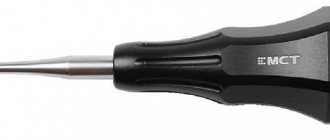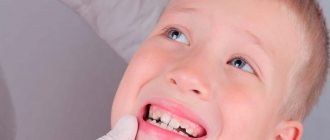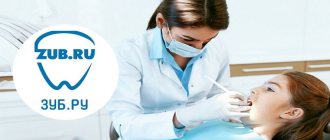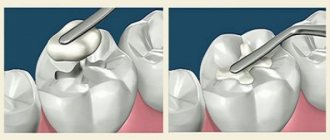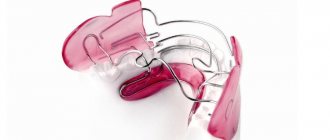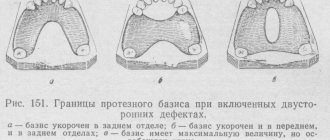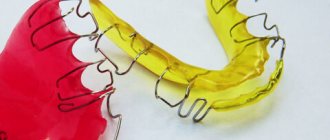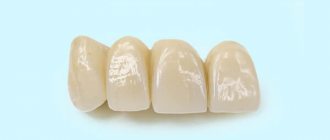1855
During the formation of the jaws and dentition in childhood, a variety of problems can arise.
One of these problems is the insufficient size of the jaws, due to which the dentition grows uneven.
This interferes with the normal development of the child’s speech, interferes with eating normally, and forms complexes associated with appearance.
To correct these problems, various devices are used in dentistry. Our story is dedicated to Klammt's devices.
Device Description
This is a removable bimaxillary device , fixed on the teeth from the incisors to the second molar, leaving the frontal units and palatal vault free, which significantly expands the surface for the tongue and improves the functionality of the dental system.
The device is designed to correct the incorrect position of the anterior elements in several types of abnormal bite.
The device received its name based on the principle of operation, i.e. it is activated during movements of the tongue and jaw , for example, during communication. Bite correction is carried out by moving teeth in a small gap between the hardware arch and the dentition.
The Klammt device is an improved model of the classic Andresen-Goipl device. But unlike its predecessor, it has smaller parameters and a lightweight elastic design, which affects wearing comfort.
The device in its design has the following parts:
- two plastic shields adjacent to the alveolar areas of both jaws from molars to canines;
- overlay plates on the side units, covering 2/3 of their surface;
- clasp for the sky in the form of a spring;
- one pair of vestibular arches for the frontal elements of both jaws, which end in horizontal U-shaped bends that prevent biting of the mucous membrane.
Important! According to indications, loops for tongue retraction, spring pushers, labial pads, and half-arches can be added to the device.
The purpose of using plates with a Bertoni screw and the timing of treatment.
Come here if you are interested in the design of the Brückle apparatus.
At this address https://www.vash-dentist.ru/ortodontiya/plastinyi/dlya-vyiravnivaniya-zubov-raznovidnosti-i-nyuansyi-primeneniya.html we’ll talk about the types of plates for straightening teeth in children.
Wearing rules
The activator is most often worn only at night, because it makes it difficult to breathe through the mouth and talk. If the pathology is complex, then additional wearing during the daytime is recommended.
You need to visit the orthodontist every 2 weeks. The doctor activates the device, adjusts the retraction arch and adds plastic to the areas of the moved dental units (if necessary).
Indications
The main indication for the use of the device is the organization of conditions for the correct formation of both jaws. Use is also indicated for other conditions, which we will consider below.
Distal type of bite
If such an anomaly is combined with a narrowed dentition and crowded anterior units. In this case, a standard activator is manufactured.
In case of severe crowding, finger-shaped springs are added to it, which normalize the position of the teeth.
Instead of a standard vestibular arch, if indicated, a semi-arch with a hook-shaped grip can be placed.
If there is a combination of an anomaly with a protrusion on the frontal units , then a standard device is manufactured to correct the defect.
Distal locking type
The activator creates conditions for the formation of support in a swept plane. In this case, the aprosimal surface of the existing milk units is sanded off and gaps are created for laying a stopper made of a special wire.
If permanent units have already grown, the device is made using impressions of their surfaces.
Also, due to the high tone of the circular oral muscles and lips, a lip bumper is introduced .
If such a bite is combined with a strong rotation of the incisors, the maxillary arch is made in the form of two semi-arches.
Mesial with simultaneous reverse overlap of incisors
With such a defect, the vestibular arch is created with a bend in the form of a semicircle to tightly abut the mandibular incisors, without putting pressure on them. Pelota are placed on the lingual surface , with a distance of 2.0 mm from the alveolar and dentition.
Open bite type
A tongue shield is added to the device. These are two bends of wire located behind the incisors (but not touching them), and prevent the tongue from contacting them.
Correction of dental anomalies with extraction of permanent units
The arch is made with a slight semicircular bend , but the degree of its fit to the teeth is determined by a specialist, based on the complexity of the case.
Protrusions
For patients with teeth positioned in front of the row, an apparatus is recommended in which all its parts are 1.5-2 mm away from the incorrectly grown units, but at the same time the arch itself should be pressed closely against the incisors .
Crossbite
If the dentition is narrowed, it is recommended to wear a device with standard equipment, the only difference being that if displacement is observed in the lower jaw, the surface of the plastic parts is made smooth and is located at some distance from the lateral units.
Devices with standard equipment are also recommended:
- to change the parameters of the jaw bone - slowing down or, on the contrary, accelerating growth (the method shows results only in children);
- to correct abnormal growth of milk units;
- to reduce the load on the chewing elements;
- to raise occlusion;
- to correct facial asymmetry caused by malocclusion.
Operating principle of the Andresen-Goipl activator
The ability to fix the lower jaw in the required (extended) position gives impetus to its development. In this regard, the growth of the upper jaw is inhibited, the bite becomes disconnected, and the work of the facial and masticatory muscles returns to normal.
Placing an inclined plane along the entire dentition makes it possible to move teeth in three planes - to the side, back and forward. This makes it possible, with some design changes and additions to the activator, to successfully use it to correct not only distal occlusion, but also other deviations of occlusion.
Contraindications
There are only two conditions limiting the use of the device:
- Intolerance to the presence of foreign structures in the mouth.
- Allergy to metal alloys.
What defects can be corrected with Invisalign clear aligners and how the device works.
This material contains detailed information about orthodontic trainers for children.
Here are fair reviews about T4k trainers.
Why are monoblock devices needed?
EXPERT OPINION
Ask a question Vagapov Zakir Irkinovich Orthodontist, work experience: 16 years “Monoblock devices are especially effective in young children from four to seven years old and are used to correct various forms of occlusion, normalize nasal breathing and straighten individual crooked teeth.”
Indications for the use of monoblock devices are as follows:
- stimulating or inhibiting the growth of the lower or upper jaw,
- creating natural conditions for the harmonious development of correct bite in a child,
- elimination of facial asymmetry,
- normalization of breathing: with the help of a device, a child can be weaned from breathing through his mouth,
- Reducing excess pressure from the lips or cheeks, which can cause crooked teeth.
A contraindication to the use of monoblock structures can only be the individual characteristics of the patient, for example, metal intolerance.
Manufacturing process
Manufacturing the device is a long and very labor-intensive process, taking place in accordance with the following algorithm of actions:
- Plastering in an occluder of jaw samples in a constructive bite.
- Designation on samples of the parameters of the basis and location of all wire parts.
- If the activator is made without making an impression of the surfaces of the lateral units, the interdental spaces in this area are filled with plaster mass, so as not to grind it off later in the finished device. If the device is made with impressions of all teeth, this stage is omitted.
- Modeling from wax a solid base for the jaws adjacent to the palatal (lingual) surface of the lateral units in the area from the molars to the canines. For the hard palate, instead of a single plastic base, a palatal clasp design is always used.
- Bending arches from a special wire having 0.8-0.9 cm in diameter, clasp - up to 1.5 cm in diameter, springs - from 0.5 mm to 0.7 cm.
- Fixing the ends of the palatal clasp into the base at the premolar site.
- Bending the clasp into an oval loop.
- In case of oral (vestibular) incisal deviation, palatal, lingual, protraction, dental, retraction or labial arches are installed.
To expand the rows, Coffin springs or special screws are installed. For certain indications, stops, overlays, shields, and pads can be additionally manufactured. - Fixing parts in a wax model when making a plastic base or attaching them with wax in an area that was not covered with plastic.
- Replacing wax with a plastic mass or forming a device from a self-hardening orthodontic mass.
- Grinding and polishing of the finished device.
- Sawing the base of both jaws in the middle or in the direction indicated by the doctor.
- Checking the screws (springs) in operation.
The finished device is handed over to a specialist for installation.
The video shows the process of making the activator.
Design features of the Andresen-Goipl activator
This orthodontic product is a closed monoblock. The activator consists of the following elements:
- plastic base for the upper and lower jaw;
- Coffin springs, manufactured using medical wire 1.2 - 1.5 mm in diameter;
- vestibular arch - made of wire 0.6 - 0.8 mm in diameter;
- a large number of guide planes;
- activating loops, clasps, screw.
The Andresen-Goipl activator is made according to individual patient models obtained on the basis of casts reflecting the expected bite after correction.
Installation and treatment tactics
The option for positioning the device in the mouth depends on the type of pathology that needs to be eliminated:
- Distal in combination with protrusion - both arches are located almost close to the cutting surface of the teeth. Lingual parts on the lower jaw are placed at the necks of the incisors to ensure movement of their bodies. Additionally, pilots can be added to increase the pressure.
- Distal bite with crowded anterior units - the vestibular maxillary arch is located at a short distance from the incisors.
It is also acceptable to add half-arches with hook-shaped grips for the lateral incisors. Palatal and lingual appliances are placed close to the incisal edges, which elevates the bite and straightens the incisors. - Blocking distal without crowding of teeth - the maxillary arch can be replaced by a labial bumper, and the mandibular arch can be located at some distance from the incisors.
- Mesial bite - the palatal parts and the mandibular arch should be tightly adjacent to the dentition. Lingual elements, on the contrary, are separated from the alveoli and dentition. The maxillary arch changes to a labial bumper.
- Open bite - both arches are placed at the gingival margins, and the tongue shield is slightly distant from the incisors.
- Protrusion - the arches are located close to the cutting edges, inside all the oral parts are moved away from the dentition. Separately, for such pathology, a version of the device with pelotes, which are located remotely from the alveolar and dentition, can be manufactured.
According to experts, the best age for correcting pathologies of the dentofacial apparatus with the Klammt device is the age of 9-10 years.
During this period, a permanent bite begins to form, active development of the jaw bones occurs, and the treatment process itself will be most effective. Using the device, the orthodontist can change the morphology of both jaws, correct the functionality of all types of muscles, normalize the position and mobility of the tongue, etc.
The device is designed to be worn around the clock for 10-24 months. (the exact duration of treatment is determined by the doctor based on the severity of the defect).
Also important for obtaining a positive result is the patient’s fulfillment of the following conditions:
- lips should close tightly;
- it is important to ensure free breathing through the nose, and if this is difficult, seek advice from an otolaryngologist;
- for the first 5-7 days the device is worn only in the afternoon and at night, and then it must be worn 24 hours;
- When eating or playing sports, the activator can be removed and placed for storage in a small container.
In the first days after placement of the device, the patient may experience speech impairment, increased salivation, and constant discomfort. After 4-6 days, these symptoms will disappear.
Important! The doctor should warn the patient that the device, being located freely in the oral cavity, may fall out during the first few days.
During the entire treatment period, you must visit an orthodontist for examination. He studies the patient’s complaints, adjusts the position of the device so that it fits loosely, but at the same time fits tightly.
Advantages and disadvantages
Compared to other devices that correct problems of the dental system, the Klammt apparatus has the following advantages:
- It is possible to simultaneously correct the position of both jaws, which shortens the treatment period.
- Patients quickly get used to the presence of the device in the mouth, and the degree of discomfort is minimal.
- The device easily corrects any crooked teeth, and this is important, especially in children during the formation of their bite.
- It is an aesthetic device due to the fact that it is located on the lingual side of the dentition.
- Helps to form correct and symmetrical facial contours.
The main disadvantage of the device is the duration of the correction. To achieve the desired result, it must be worn for a fairly long period of time (for complex pathologies - several years).
Patients also indicate several other design flaws that cause them some inconvenience:
- must be worn around the clock;
- has a complex and inconvenient structure;
- has age restrictions for use;
- You may be allergic to the metal used in the manufacture of some parts of the device.
Pros and cons of Klammt's activator
The advantages of the activator include:
- comfort in using the orthodontic design, relative to existing analogues;
- high performance;
- the ability to eliminate defects in both jaws at once;
- quite aesthetic appearance;
- does not interfere with articulation;
- corrects facial muscles;
- Helps correct facial asymmetry.
The disadvantages of the Klammt activator are:
- limited age of patients (up to 10 years);
- 24-hour use of the structure;
- the reluctance of children, due to their age, to comply with the schedule for using the activator, therefore, strict control by adults is needed.
Retention period
After the teeth take the correct position and the bite is normalized, the retention period . At this time, the results obtained are consolidated and bone tissue is rebuilt, i.e., when the processes of formation and resorption are leveled out.
The purpose of this stage is to hold the teeth in their new position after the need for the 24-hour presence of the device in the mouth is no longer necessary. This is a long period, in some cases lasting two years.
In orthodontics, several types of devices are used to stabilize the result. Which one will be recommended to the patient depends on his age, severity of the defect and correction plan. Most often, doctors recommend wearing retainers and orthodontic plates.
Important! All medical recommendations during the retention period should be approached with the same responsibility as during the treatment period. It was noted that the faster the treatment result was obtained, the greater the risk of relapse.
General introduction and purpose of application
Bionators are myofunctional devices with combined effects. The purpose of their use in orthodontics is to eliminate functional or morphological disorders of the dental system during periods of primary or permanent dentition.
The devices can rearrange the position and inclination of the teeth, expand/contract the jaws and rows of teeth, and eliminate the incorrect relationship of the jaws relative to each other. Bionators work well with facial muscles and jaw ligaments.
Successful correction of malocclusions using devices is ensured by:
- reliable fastening and stable support;
- sufficient strength to move and turn teeth;
- the absence of an obstacle in the way of displaced units, and the availability of space in a row.
Price
The Klammt appliance is an inexpensive orthodontic device. Its approximate cost in different clinics ranges from 14 thousand rubles. up to 19 thousand rubles
To these costs you may have to add fees for additional services, the costs of which can be found in the table.
| Service | Cost in rubles | |
| Initial consultation | 300—500 | |
| Repeated consultation | 300 | |
| Observation during the retention period | 200 | |
| Full diagnostics, including taking an impression of the jaw, determining the bite, anthropometric analysis, drawing up a treatment plan, making a plaster model | 4 500 | |
| Device correction | 500 | |
| Retaining plates | 15 000 | |
| Retainers | Removable | 3 000 |
| Fixed | 7 000 | |
A complete list of necessary services and their exact cost are indicated to the patient after diagnostic measures.
Reviews
The Klammt device is not particularly popular among patients, which is mainly explained by its complex structure and the length of time it is worn. But in terms of the quality of work, the device is not inferior to all other designs used in orthodontics.
You can share your experience of correcting your bite using this device or express your opinion regarding the effectiveness and appropriateness of its use by leaving a comment on this article.
If you find an error, please select a piece of text and press Ctrl+Enter.
Tags Klammt apparatus plates for teeth straightening
Did you like the article? stay tuned
Previous article
The use of an angular abutment to achieve high aesthetic prosthetics
Next article
The procedure for polishing a prosthesis to improve strength and aesthetic qualities



